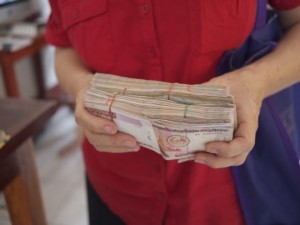
A Fistful of Kip: "You should have seen how big the stack would've been before they started printing larger bills", Carol said.
When Lauren and I first visited the @My Library last June, we noticed two things right away: That the students loved using computers — and that their shared internet speed was slow… painfully, glacially slow! When one student named Morthor asked us to sit with her and help fix her web email, we couldn’t even get through to the website. Our connection was so bad that, essentially, it was refused.
“How much does faster internet cost?”, I asked Carol.
“A lot — especially when adjusted for the cost of living here.” After I left, she sent me the exact figure: $1900 per year for a connection speed which, in the United States, would cost 1/10th that price.
Buy A Ticket To The World?
This is the “Chicken / Egg Dilemma” of developing countries: The infrastructure that they need to lift themselves out of entrenched poverty is so expensive that it is almost completely out-of-reach.
There was no doubt that a usable internet connection would open up any number of opportunities for these hard-working students. In Vietnam and Thailand (the Lao Republic’s “next-door neighbors”), where the internet is comparatively cheap and readily available, you can walk the streets of Saigon or Bangkok and see for yourself the transformative effect that it’s having culturally and economically. Even though it’s easy for me to point out the perils and shortcomings of development and globalization, the people in the developing world that I talk to about it say — from the construction cranes to the abundant internet cafés packed with people — that these changes are not only a good thing, but an incredibly good thing.
In Laos, however, they are still on the outside looking in. In a place where books are scarce and modern economic development is just beginning, everyone here — students, business people, aid organizations — understands the positive benefits that connection brings. Being able to reach out into the world to ask for the help you need (or to offer the things that you have) is incredibly important in the Lao Republic. And yet, the scarcity of resources here forces everyone to ask “Can we really afford this?”. The almost $4000 that it would take to get both groups connected is a lot of money in any part of the world — and here, it’s close to twice what most people make in an entire year. But after talking with Carol, Justin, and the students, it was pretty clear that this was not just something that they wanted, but something that they needed.
“Is there anything I can do to help make this happen for them?”, I wondered.
An Idea To Help… In My Own Way
As Lauren and I continued our travels, I couldn’t get that question out of my mind… but I wasn’t sure that I had an answer to it. After all, I had never really volunteered or raised funds for Non-Profits before. Was I really willing — or even able — to raise that kind of money for people that I just met?
A couple of weeks before returning home, I got an email from a corporate client asking if I could do a project for them. It instantly gave me an idea for how I could help The Language Project and Village Science… and so I decided to take a leap into something new.
I made the company a counter-proposal: Essentially, I told them that I would do the work they were asking for — and a lot more — in exchange for donating directly to each group for one year’s worth of internet service in lieu of my normal fee. To their great credit, they didn’t balk at this somewhat unconventional arrangement and agreed almost immediately! They got the work they wanted, extra stuff on top of that, a tax-deduction for their charitable donation, and some excellent PR goodwill if they wanted to publicize their involvement. Both groups and their students each got a year’s worth of internet — and a relationship with a good corporate partner who might be able to help in other ways in the future.
What did I get? I got to help make that happen.
***
Donating money to causes like these is important, but part of why I made this trip to Laos was to take this project “the last mile”. I wanted to make sure that Carol and Justin not only got the money for the internet, but that I could use my skills to ensure that it worked well for them.
In a cash-based economy like Laos, Carol had to quite literally hand over a stack of money to her DSL provider to establish service — which is both a huge leap of faith and also an awesome photo! I am happy to say that, after a few early technical glitches, it looks as if the students at @My Library finally got their faster, more reliable internet service this morning.1
Now that things are up-and-running, we move on to our next item for the students: Setting up the automatic email reminders for their overdue library books! 😉
- And Village Science should have their connection shortly! [↩]